In the Spotlight #6: Metal Halide Miscellany
 Lately I have been fielding a number of technical questions regarding metal halide HID bulbs, so I figured I would use this article to address them because I’m sure that these few customers are not the only ones who have ever scratched their heads over some of these technical issues. In this article I will explain the importance of (1) lamp burning positions, (2) pulse-start versus probe-start lamps, and lastly (3) the difference between quartz and ceramic metal halide lamps.
Lately I have been fielding a number of technical questions regarding metal halide HID bulbs, so I figured I would use this article to address them because I’m sure that these few customers are not the only ones who have ever scratched their heads over some of these technical issues. In this article I will explain the importance of (1) lamp burning positions, (2) pulse-start versus probe-start lamps, and lastly (3) the difference between quartz and ceramic metal halide lamps. 1. Burning position denotes the proper orientation of the bulb inside the fixture. Manufacturers test their lamps extensively to determine what position, whether it be, base-up, base-down, horizontal, vertical ± 15˚, etc. maximizes the life of the lamp. This will depend largely on the shape or construction of lamp, for example whether it is a short-arc lamp or ED17, and what gasses are inside of it. One should note that many lamps also have a universal burning position, meaning that they can be oriented any way. Manufacturers also denote burning positions to ensure that lamps operate safely and avoid premature failure. Burning position is also important with regard to consistent color rendering. Even lamps of the same model by the same manufacturer can very well have varying color rendering and color characteristics. To help ensure that the light is uniform, manufacturers stipulate burning positions to limit this variability in color quality.
2. Because metal halides are a gas based lamp, they require an initial burst of electrical current to sufficiently excite the gases inside the glass envelop so they can emit light. Probe start and pulse start refers to two different ways that the ignition of the lamp occurs to sufficiently excite the gasses inside the lamp. Older metal halide lamps typically use probe start lamps, which feature a starter electrode. The initial electrical current is produced by the ballast and travels up a conductor to the starter electrode which then forms an arc with one of the two central electrodes and thus facilitates the complete ignition of the lamp. The shortcoming of probe start lamps is that as the tungsten electrode is heated and deteriorates it blackens the glass envelope, reducing the efficiency and efficacy of the lamp. Pulse start lamps eliminate the need for the starter electrode by integrating the ignitor into the ballast which provides an initial 3kV to 5kV burst of electricity that forms the arc between the two electrodes. This streamlined system not only reduces bulb blackening, but also allows the lamp to function with a smaller envelope, making it more efficient. You should also be aware that pulse start bulbs warm up, or reach full luminosity, faster than probe start bulbs and also re-ignite faster, making them more convenient and easier to use.
3. Today, metal halide lamps’ arc tube are housed in one of two different materials: quartz class or a ceramic housing. Ceramic metal halide lamps are newer and are typically more expensive. Ceramic metal halide lamps can withstand higher temperatures and therefore have improved life hour ratings and better lumen maintenance over time. Furthermore, ceramic metal halides have better color rendering and better color consistency than quartz metal halide lamps, making them a good choice if you need a high performance lamp that will faithfully render color, as in medical and scientific applications.
Hopefully this article has clarified these important technical issues. Remember that for lamps like metal halides that require special care when using them, you want to make sure you have all of your technical bases covered before choosing the right one for you. Please continue to post your questions and comments on our blog and Facebook or call us at 1-877-622-0897 with any further inquires you have.













Comments